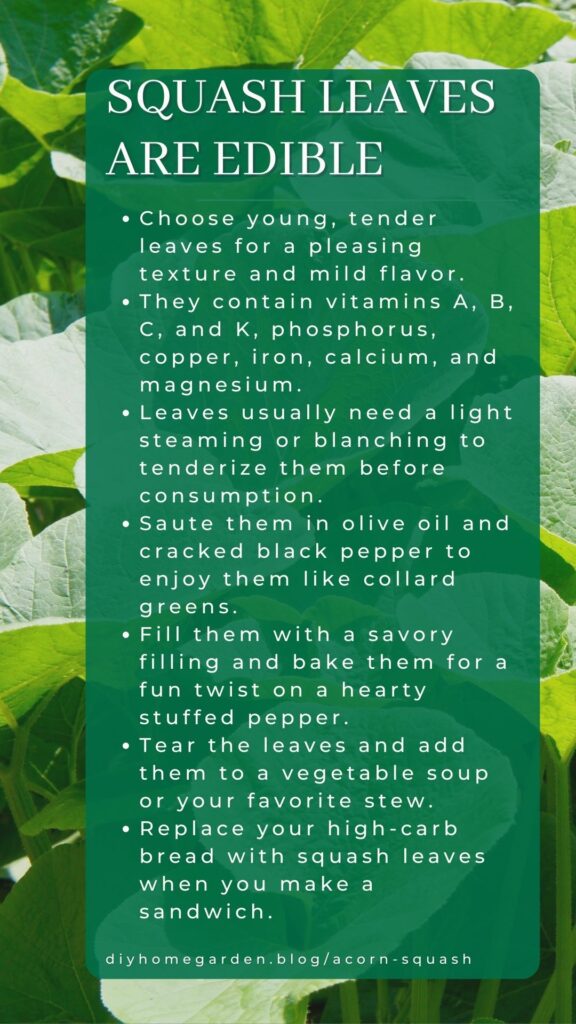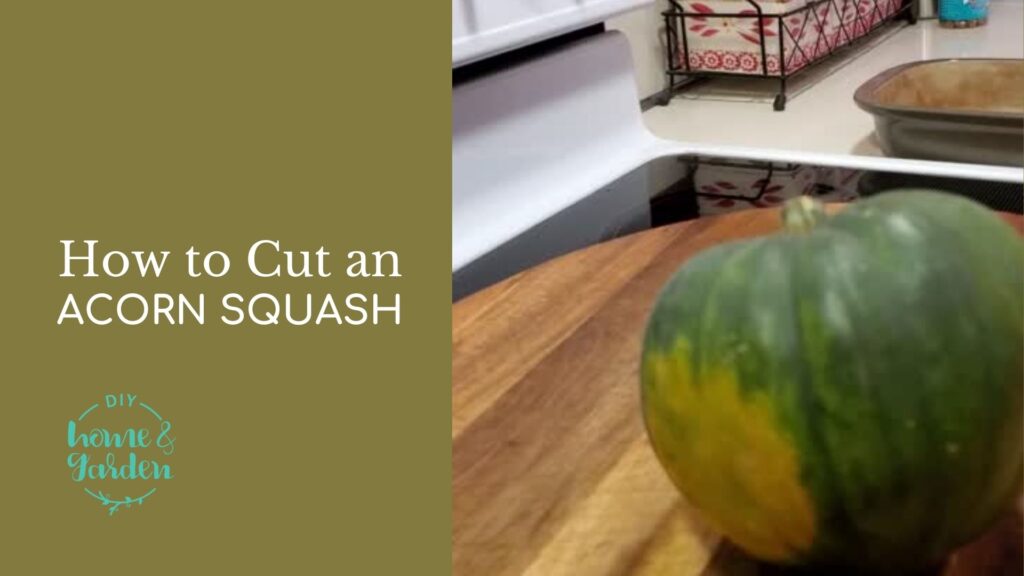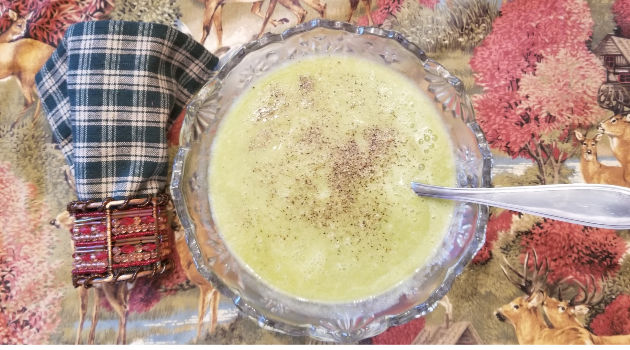Acorn squash (Cucurbita pepo var. turbinate). Will this nutrient-dense vegetable find its way to your table this fall? I hope the answer is yes.
A corn squash is a favorite for both novice and seasoned gardeners considering its ease of growing and care, plus it’s hardy, fast-maturing, and high-yielding.
The dark-green fruit features a rounded acorn-like shape with sweet orange flesh inside.
Native to North and Central America, acorn thrives in almost all climates with growing seasons lasting from the last early spring frost to the fall’s first frost.
It especially grows best in USDA plant hardiness zones 4 and above.
Frequently Asked Questions About Acorn Squash
Before we explore the step-by-step growing and care guide, here are the answers to some of the commonly asked questions about acorn squash.
How long do acorn squash take to grow?
Acorn squash takes approximately seventy to a hundred days to mature from seed to harvest.
How long do squash plants produce? Will acorn squash keep producing?
Most squashes continue fruiting until killed by the fall frost, although production declines after about four weeks.
How many acorn squash will one plant produce?
Acorn squash plants are high-yielding with some varieties, like the ‘Honey Bear’, producing over four fruits per plant.
Usually, though, not all ripen at the same time; meaning you can continue the harvest until all the squashes ripen.
What does acorn squash look like when it’s growing?
Acorn squash plants feature large vines (that can spread up to twelve feet, depending on the available space) on which grow large green leaves and trumpet-like yellow blossoms that precede fruit production.
Depending on the variety, the stout, round, and ridged fruits can either be dark green, bright yellow, white or variegated on the outside.
The dark green variety is the most common, usually, with yellow and bright orange spotting on the top or side.
How do I know when my acorn squash is ready to pick?
Your acorn squash is ready for harvest once the skin thickens (hardens) and can resist piercing by a fingernail.
Alternatively, when the plant’s stem (attached to the fruit) withers and becomes brown, it is a good indication that the fruit has fully ripened.
Harvest just before your area’s first hard frost of the growing season.

Should you prune acorn squash plants?
Acorn squash plants don’t necessarily require pruning; however, it’s a great way to speed things up, especially, when the growing season is coming to a close.
By pruning, you help the plant redirect its energy into ripening and plumping up the existing fruits—rather than foliage production. You can also prune the plants if you’re short on space.
Should I pinch off squash flowers?
Though not necessary, removing the flowers helps boost the plants’ yield.
Normally, squash plants produce fewer female blooms than males, so you can pinch off the excess male flowers to allow the plants to focus on fruit development.
To help you differentiate the two; female flowers exhibit a tiny fruit beneath the flower while the males grow on long narrow stems.
Also, look at the reproductive organs at the center of the flower. Females carry the stigma.
Why are my squash leaves turning yellow and dying?
Squash leaves will most likely yellow out when inadequately or excessively watered.
Be sure to offer the plants at least an inch of water a week to keep the soil moist (approximately 8-12 inches down) so the squash stays hydrated.
The yellowing could also be caused by nutritional imbalance, pests (mainly whiteflies and squash bugs), or bacterial wilt.
Your best bet against all these is preventive. Ensure your plants are properly watered and fertilized to minimize their vulnerability to pests and diseases.
Should you remove yellow leaves from squash plants?
No, unless it’s a bacterial wilt issue, in which case, the leaves will quickly wilt once the yellowing begins, then eventually brown and die off. There isn’t a way around this disease.
Otherwise, avoid removing the leaves because doing so further exposes the plant to bacteria, viruses, and other parasites.
Why is my squash so small? And How do you increase yield in squash?
Squash under-development may be a result of several factors including nutrient deficiency, poorly draining soils, insufficient soil moisture, unbalanced soil pH level, cold temperatures, inadequate exposure to direct sunlight, and pressure from pests and diseases.
To boost your squash productivity and ensure maximum fruit development, make sure the soil is well-draining and organic-matter rich, the plants are adequately hydrated, and the soil pH is right (6.0-6.8).
The flowers should also be well pollinated. If you have no bees around or are hardly visited by pollinators, consider using a paintbrush to hand-pollinate the blooms.
Avoid fertilizing during flowering and fruiting periods, unless necessary, as too much fertilizer may trigger blossom drop or reduced fruiting.
How do you thin out squash plants?
Identify the tallest and strongest seedlings you’d like to keep then prune out the weaker, smaller ones using your fingers.
Alternatively use a pair of sharp gardening scissors.
Avoid yanking out the weaker seedlings so you don’t hurt the other plants’ root systems.
What happens if you don’t thin seedlings?
When left un-thinned, crowded seedlings will compete for light, nutrients, root space, and other essential growth needs, therefore, compromising their development and productivity.
It also increases their susceptibility to diseases.
How often should I water my squash plants?
Irrigate your squash plants once every week with an inch of water, but more frequently in extremely hot weather or if you have sandy soil.
Should I top squash plants?
This depends on the space you have available for the plant and what works best for you.
As long as you don’t injure the main vine, pruning back won’t hurt your squash plants, their fruits, or diminish their flavor.
It’s the best way to train the plant to grow within the allocated area.
Can you eat squash leaves?
Squash leaves (greens) are not only edible but also delicious and highly nutritious, says a horticulturist. The younger, tender leaves are more palatable.
They contain healthy vitamins and minerals like iron and calcium, vitamins A, B, C, and K, phosphorus, copper, and magnesium. These nutrients help boost your immune system and support your overall health.

How to Grow Acorn Squash
You can either grow acorn squash from seeds or buy seedlings from your local garden center, preferably in the spring.
Site Preparation and Planting
- Select a section of your garden where you commit to growing the vegetable considering that acorn squash roots dislike disturbance, especially after the seedling stage.
If starting the seeds indoors, use biodegradable peat pots that dissolve into the ground, so the roots remain intact during transplanting.
- The location should be spacious enough and receive full sun, at least six to eight hours a day.
- Plant once the soil temperatures hit 600F to ensure adequate warmth for seed germination.
- Till the soil to a depth of at least eight inches down to help ensure ample drainage and sufficient room for the squash roots to extend.
- Add in compost or a balanced fertilizer for a boost of nutrients.
- If your soil is more on the acidic side, mix in a bit of lime to help balance the pH level; then water thoroughly.
- Wait a few days then dig up the soil again as deep as possible to get the fertilizer and limestone mixed in properly.
- Then go ahead and create mound(s) about three or four inches high and approximately thirty inches wide. At this point, you can add in compost or well-rotted manure, especially if you intend to grow the squash organically.
- In a mound, plant four to six acorn squash seeds; each in their small (one inch deep) separate holes. Cover loosely with topsoil. You don’t need mounds if growing bush varieties in containers or planting near a fence or trellis.
- Once the seeds sprout and are three inches tall, thin down to two or three strong and healthy seedlings per mound.
Note: Acorn squash won’t tolerate frost, so delay planting until after all the danger of frost has passed.
Caring for Acorn Squash
Offer a feed—To quench their heavy appetite for nutrients, be sure to fertilize your acorn squash plants with a balanced liquid fertilizer or compost tea every fourteen to twenty-one days during the growing season.
Alternatively, add manure or compost to the mounds halfway into the growing season.
- Thin: Thinning helps ensure proper ventilation, thus reducing the plant’s vulnerability to diseases such as powdery mildew.
- Mulch: Apply mulch around the plants to help control weeds and also keep the soil consistently moist. Ensure the soil is at least 750 F if using organic mulch as it can prevent your soil from warming up.
- Watering: Irrigate your squash mounds once the soil starts to dry out, making sure to aim the water to the base of the plant rather than the leaves to avoid powdery mildew.
- Remove squash bugs as you notice them: These bugs suck out the sap from the plants, wilting them to death. Regularly inspect the undersides of your squash leaves and remove any eggs as you come across them. You can also apply neem oil or insecticidal soap to help keep the pests at bay.
Harvesting Acorn Squash
- When nearing maturity, the acorn squash shell will turn dark green. Test their rind firmness in September or October.
- Thick and strong skin that resists a finger scrape is a good indication that the fruit is ready for harvest.
- Use a pair of garden or kitchen scissors to cut the squash from the vine, making sure to leave approximately three or four inches of the stem attached to it.
- Store in a cool, dark, and dry place—ideally a spot with temperatures of around 50-550F.
- When stored correctly, acorn squash can keep fresh for up to three months.
Final Thoughts on Growing Acorn Squash
An excellent source of vitamins, fiber, iron, and powerful antioxidants, acorn squash plays a vital role in your overall health—the more reason it shouldn’t miss on your gardening list this season.
However, be sure to choose the right variety that suits your growing season and space needs.
For shorter growing seasons or if intending to plant after your earlier spring harvest, choose a fast-maturing variety like the Table Ace (taking only around eighty days to mature).
To save on space, consider growing the squashes upright on a sturdy fence or trellis so you train them to your desired direction and shape. Use mesh bags to reinforce the existing fruit support system, if necessary.
Now that you have everything you need to successfully grow and harvest acorn squash, it’s time to get to work!



